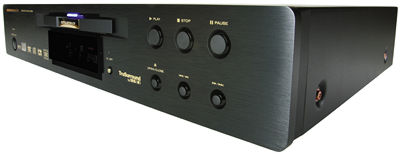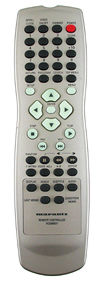Marantz DV-8300 SACD & DVD-Video/Audio player Page 2

The result was similar when I compared the DV-8300 with the Sony DVP-NS999ES. But here the differences were much more difficult to spot, so I moved the comparison to a bigger screen (80 inches wide), using Sony's very sharp VPL-VW12HT LCD projector. In an interlaced comparison, the NS999ES was just barely softer than the DV-8300, but on a number of shots in Bedazzled this was enough to make the edges look a little more natural on the Sony. While careful adjustment of the available Sharpness controls produced virtually identical images from the two machines, I could squeeze an extra milligram of sharpness from the Marantz—but this was meaningful only with the very best, most edge-enhancement-free DVDs.
Interestingly, even with the initial sharpness setup, the players looked very much the same in progressive mode on the LCD projector, though the Marantz was noticeably softer than its interlaced performance. This was not the case on the smaller Hitachi RPTV. There, the images produced by the Marantz (deinterlacing issues aside) were identical in interlaced and progressive modes. This discrepancy remains a puzzle, but it might be related to differences in the way the two displays upconvert their inputs: the Hitachi to 540p, the Sony LCD to 720p.
In short, improving significantly on the Marantz's basic video performance with today's best DVDs would be a challenge at anything like a reasonable price.
Listening
In my recent experience, agonizing over the differences in sound quality between DVD players with today's best Dolby Digital and DTS DVD soundtracks is frustrating and ultimately unrewarding. Whether I listened through the priciest surround processor on the market or a modestly priced receiver, moving from the Marantz to other DVD players—even far more expensive ones—didn't materially change the sound I got from Dolby Digital or DTS soundtracks using a digital connection.
The DV-8300's built-in Dolby Digital and DTS decoders were slightly less open-sounding than the corresponding decoders in Outlaw's remarkable little 1050 receiver, a result I credit to the Outlaw's more flexible bass management. In any case, the best recent film soundtracks, from The Lord of the Rings: The Fellowship of the Ring to Star Wars: Episode II—Attack of the Clones, sounded awesome on the Marantz.
But the DV-8300 does not live by movie soundtracks alone. Many will take its soundtrack performance for granted and buy it primarily because it can play back both SACD and DVD-Audio music recordings. How did it fare in those roles?
 I began with DVD-Audio. The sound quality of the DVD-A discs I had on hand varied considerably, possibly because most of them were pop mixes, which tend to be all over the map, no matter how high the format's inherent quality. But it takes only a few good recordings to prove the potential of a piece of equipment, and I found three. Aaron Neville's Devotion (Silverline 86028-9) sounded open and clean without being overbright. Though the overall recording was not remarkable, and the backup singing in the surround channels did nothing for me, the balance was well chosen.
I began with DVD-Audio. The sound quality of the DVD-A discs I had on hand varied considerably, possibly because most of them were pop mixes, which tend to be all over the map, no matter how high the format's inherent quality. But it takes only a few good recordings to prove the potential of a piece of equipment, and I found three. Aaron Neville's Devotion (Silverline 86028-9) sounded open and clean without being overbright. Though the overall recording was not remarkable, and the backup singing in the surround channels did nothing for me, the balance was well chosen.
More impressive was Ton Koopman's Organ Spectacular (Teldec 8573-82041-9), an organ recording with a very spacious acoustic. It was a bit lacking in extreme bottom end, even with the big and certainly not bass-deficient Revel F50 speakers (review in progress) holding up the left and right front channels. Paul Simon's You're the One (Warner Bros. 47844-9) sounded best of all. The midrange and highs on this recording were remarkably silky and smooth, yet full of delicate details. The only shortcoming was a slightly overwarm midbass, most noticeable on Simon's vocals.
Moving on to multichannel SACD, James Taylor's Hourglass (Columbia CS 67912) was a sonic delight—instruments pop up occasionally in the surrounds, but the mix is tastefully done, never overbearing. The sound was silky-smooth and well-balanced, if slightly on the warm side. Celtic Spectacular (Telarc SACD-60571) was also smooth and warm, with a rich—perhaps slightly too rich—ambience. Neither recording had any edginess at all. And Gaudeamus' Sacred Feast (DMP SACD-09) was one of the most convincing recordings I've ever heard of a chorus in a large, resonant church.
Through all of this, I was never much aware of what the bass management was doing or not doing. As noted above, I did tend to hear a bit too much warmth, which suggests an overlap of the sounds reproduced by the left and right front speakers and the subwoofer, or that the rolloff in the Marantz's lowpass filter might not be steep enough. But the sound was not muddled or unpleasant. Nevertheless, as with all DVD players I know (with the possible exception of the EAD DVDMaster 8000Pro), you'll get the best results from DVD-Audio and SACD if you use full-range speakers all around or perform the bass management with an outboard device, such as the Outlaw ICBM-1.
The Marantz itself performs no bass management with CDs, so I did all of my CD listening using the player's digital outputs. It sounded exceptionally detailed and open, with fine depth, solid bass, and a particularly airy top end. Its performance seemed limited mainly by the quality of the D/A conversion used in the receiver or surround processor.
About the only criticism I have of the player's digital-out CD performance is of a slight lack of warmth and body from the midbass up into the midrange. This opened up the sound, but also made the Marantz unforgiving of inherently bright material. The far more expensive Proceed PMDT sounds just as detailed and also a little more rich and punchy. At a price comparable to the Marantz, the Sony DVP-NS999ES is a bit more full-bodied but with slightly less air and transparency on top. All three were so close in overall sound that your preference will likely depend more on the system and program material than on the players themselves.
Conclusions
To get the very best from DVD-Audio and SACD, I recommend using some sort of outboard bass-management box like the Outlaw ICBM-1 with most current players, including this one—unless you use full-range speakers in each channel. Apart from that limitation, there's not much to criticize in the DV-8300. It may be pricey as today's DVD players go, but it offers the sort of high-end playback from all sources you'd normally expect to pay even more to get. Its audio performance can challenge that of far more expensive players without being embarrassed by the comparison. On the video side, I found no aspect of its performance that came up short. The Marantz DV-8300 is a winner.












































